Predictive maintenance (PdM) is based on data collection from various sensors to build statistical models that can identify potential failures before they occur. This method can use a wide range of tools, usually in the cloud. Condition Monitoring (CM) monitors various parameters, which can be used to highlight problems and allow preventive maintenance to be scheduled to avoid damage. Continuous condition monitoring technology is usually used in equipment such as compressors, pumps and motors.
STEVAL-BFA001V1B is a predictive maintenance kit designed for condition monitoring (CM) and predictive maintenance (PdM) with sensors and IO-Link functions to monitor the environment, acoustics and vibration data. The hardware kit includes industrial sensors Board (STEVAL-IDP005V1), used for ST-LINK/V2-1 programming and debugging, an industrial M12 cable, used for power supply or connection with the main port. Use standard multi-pole cable management connection, one of the wires is used for IO-Link data, one is used for L+ wire (positive supply voltage pole), and the other is used for L-wire (negative supply voltage pole).
STEVAL-IDP005V1 is specially designed in size (50mm x 9mm x 9mm) to reflect real industrial applications and needs. The package includes dedicated algorithms for advanced time and frequency domain signal processing, as well as analysis of 3D digital accelerometers with a flat bandwidth of 3 kHz. The software package includes drivers for pressure, relative humidity and temperature sensor monitoring. The audio algorithm for acoustic emission (AE) is also part of this package. The program runs on a high-performance STM32F469AI, ARM®Cortex®-M4, 32-bit microcontroller, and the sensor data analysis results are sent through a wired connection based on the IO-Link device transceiver. The STEVAL-BFA001V1B reference design is suitable for monitoring motors, pumps and Fans can accelerate the development of predictive maintenance solutions. The software package also allows connection with a multi-port evaluation board with STEVAL-IDP004V1 IO-Link master control function; the PC GUI included in the package displays algorithm output and sensor data. By simply connecting the STEVAL-IDP005V1 to the PC through the STEVAL-UKI001V1 adapter and ST-LINK/V2-1 on any STM32 Nucleo-64 development board, you can also use a public terminal emulator to display data on the PC. The program is available for free on STSW-BFA001V1.
Power management
1. L6984 is a step-down monolithic switching regulator that can provide up to 400 mA of DC. The adjustable range of the output voltage is 0.9V. The fixed 3.3 V VOUT does not require an external resistor divider. This "low power mode" (LCM) maximizes efficiency at light loads and controls output voltage ripple. This "low noise mode" (LNM) makes the switching frequency almost constant within the load current range. The PGOOD open collector output can achieve output voltage sequencing during the power-up phase. The synchronous rectifier, designed for high efficiency and high switching frequency under medium and heavy loads, makes the application size compact. Pulse-by-pulse current sensing on the low-side power element realizes effective constant current protection.
2. LDK220 is a low-dropout voltage regulator that can provide a maximum output current of 200 mA. The input voltage range is 2.5 V to 13.2 V, and the typical differential pressure is 100 mV. Ceramic capacitors stabilize it on the output. The extremely low voltage drop, low quiescent current and low noise make it suitable for industrial applications. Enabling the logic control function puts the LDK220 in shutdown mode, allowing current consumption to be less than 1μA. The device also includes short-circuit constant current limiting and thermal protection.
Microcontroller
The STM32F469AI microcontroller is based on a high-performance ARM®Cortex®-M432-bit RISC core running at a frequency of up to 180 MHz. The Cortex®-M4 core has a floating-point unit (FPU) single precision and supports all ARM® single precision data processing instructions and data types. It also implements a full set of DSP instructions and a memory protection unit (MPU) to enhance application security. The device integrates high-speed embedded memory (maximum 2 MB, maximum 384 Kb Flash memory). SRAM), up to 4 KB of spare SRAM and various enhanced I/O and peripherals connected to it. Two APB buses, two AHB buses and a 32-bit multi-AHB bus matrix. The device provides three 12-bit ADCs, two DACs, a low-power RTC, twelve general-purpose 16-bit timers, including two PWM timers for motor control, two general-purpose 32-bit timers and A true random number generator (RNG). The microcontroller has the following standard and advanced communication interfaces:
Sensor
1. ISM330DLC is a system-in-package with a high-performance 3D digital accelerometer and a 3D digital gyroscope tailored for Industry 4.0 applications. ST's MEMS sensor module series make full use of already used in the production of micromechanical accelerometers and gyroscopes. Various sensor elements are manufactured by special micro-processing technology, and the IC interface is developed using CMOS technology. Special circuits can be designed and trimmed to better match the characteristics of the sensor elements. In ISM330DLC, the sensing elements of the accelerometer and gyroscope are all mounted on the same silicon chip on the sensor, thus ensuring excellent stability and robustness. The full-scale acceleration range of ISM330DLC is ±2 / ±4 / ±8 / ±16 g, and the angular rate range is ±125 / ±250 / ±500 / ±1000 / ±2000 dps. With ultra-low power consumption (high performance, combined 0.75 mA) to provide high precision and stability mode), it can also achieve long-lasting battery-powered applications in the industrial field. ISM330DLC includes a dedicated configurable signal processing path with low latency, low noise and
Dedicated filtering dedicated to control loop stability. The data can be obtained from the dedicated signal path and provided through the auxiliary SPI interface, which can be configured for the gyroscope and accelerometer. High performance, high quality, small size, low power consumption and high mechanical durability make ISM330DLC the first choice for system designers who create and manufacture systems
Multifunctional and reliable product. ISM330DLC adopts plastic ground grid array (LGA) package. STSW-BFA001V1 firmware package includes application and demonstration firmware supportAccelerometer part.
2. HTS221 is an ultra-compact sensor for relative humidity and temperature. It includes a sensing element and mixed-signal ASIC to provide measurement information through a digital serial interface. The sensing element is composed of a polymer dielectric planar capacitor structure that can detect relative voltage and humidity changes, and is manufactured using a dedicated ST process. HTS221 adopts a small top hat ground grid array (HLGA) package, which is guaranteed to work under the following conditions: the temperature range is -40°C to +120°C.
3. LPS22HB is an ultra-compact piezoresistive absolute pressure sensor that can be used as a digital output barometer. The device includes a sensing element and an IC interface to communicate with it from the sensing element to the application via I2C or SPI. The sensor element that detects the absolute pressure uses a dedicated process developed by ST. LPS22HB is available in a full mold hole LGA package (HLGA). It is guaranteed to work in the temperature range from -40°C to +85°C. The packaging has holes to allow external pressure to reach the sensing element.
4. MP34DT05-A is a built-in ultra-compact, low-power, omnidirectional digital MEMS microphone with capacitive sensing elements and IC interface. The use of special silicon to manufacture sensor elements capable of detecting sound waves is specifically used in the micro-machining process of producing audio sensors. The IC interface is manufactured using CMOS technology, and a dedicated circuit that can provide the following functions can be designed: External digital signals in PDM format. MP34DT05-A is a low-distortion digital microphone with a signal-to-noise ratio of 64 dB and a sensitivity of -26 dBFS±3 dB. MP34DT05-A adopts SMD compatible, EMI shielded top port, and is guaranteed to work in the extended temperature range of -40°C to +85°C.
IO-LINK communication
The STEVAL-IDP005V1 board has an IO-Link connection on the M12 A coded connector. IO-Link is an industry standard for hardware connection. The standard stipulates:
The standard also establishes two different data communication methods:
1. Pure serial data communication (SDCI) with detailed protocol structure, used to manage sensor parameters and sensor data.
2. Simple level conversion from high level to low level, and vice versa, only indicating sensor status. The use of IO-Link system has several advantages, such as:
L6362A
L6362A is an IO-Link transceiver device supported by PHY2 (3-wire connection) in COM1 (4.8 kbaud), COM2 (38.4 kbaud) and COM3 (230.4 kbaud) modes. The output stage can be configured as high-end, low-end or push-pull through hardware connection, it can drive resistance, capacitance and inductive loads. The IC can use the serial data communication interface (SDCI) to connect the sensor node to the host based on the IO-Link protocol and standard I/O mode (SIO). Use 24 V industrial power supply to manage the communication bus voltage. The VCC, GND, OUTH, OUTL and I/Q pins of L6362A have reverse polarity protection. The IC also has protection against output short circuits, overvoltage and fast transient conditions (±1 kV, 500Ω and 18μF coupling).
The software runs on the STM32F469AI microcontroller and includes drivers for sensor devices HTS221, LPS25HB, ISM330DLC (only accelerometers are supported), MP34DT05-A and M95M01-DF. This software package integrates complete middleware and algorithms for accelerometer data signal processing, so that rotating equipment such as motors, pumps and fans can be monitored in the time and frequency domains, and the maximum accelerometer output data rate Bandwidth function (up to ODR / 2 = 3.3kHz). The software package includes audio library middleware to perform acoustic emission analysis. You can monitor environmental, acoustic and vibration data through a terminal emulator. The software comes with different demonstrations and applications to monitor sensor data and output algorithm results. One demonstration is based on warning and alarm conditions in the time domain and spectral bands with programmable thresholds. This software package has IO-Link function (not including IO-Link stack), and has the demonstration of communicating with STEVAL-IDP004V1 IO-Link-master-capable multi-port evaluation board.
A set of firmware examples for building condition monitoring and predictive maintenance application middleware based on 3D digital accelerometers, environmental and acoustic MEMS sensors, including advanced time and frequency domain signal processing algorithms for vibration analysis. Programmable FFT size ( 512, 1024 or 2048 points), programmable FFT average and overlap, programmable window (flat top, Hanning, Hamming), speed RMS moving average, maximum acceleration peak, middleware integrated with microphone algorithm, used for: PDM To PCM sound pressure audio, FFT is the firmware package developed for STM32F469AI, which can be easily transplanted to different MCU series, and monitor PC data through any free terminal emulator and STEVAL-IDP004V1 multi-port evaluation board with IO-Link-master function A sample demo firmware that communicates with a dedicated PC GUI.
► Scenario application diagram

► Product entity diagram
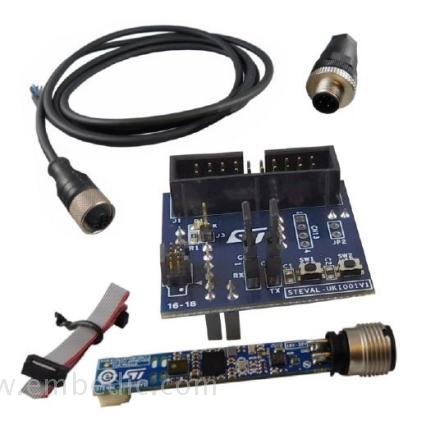
► Scheme block diagram
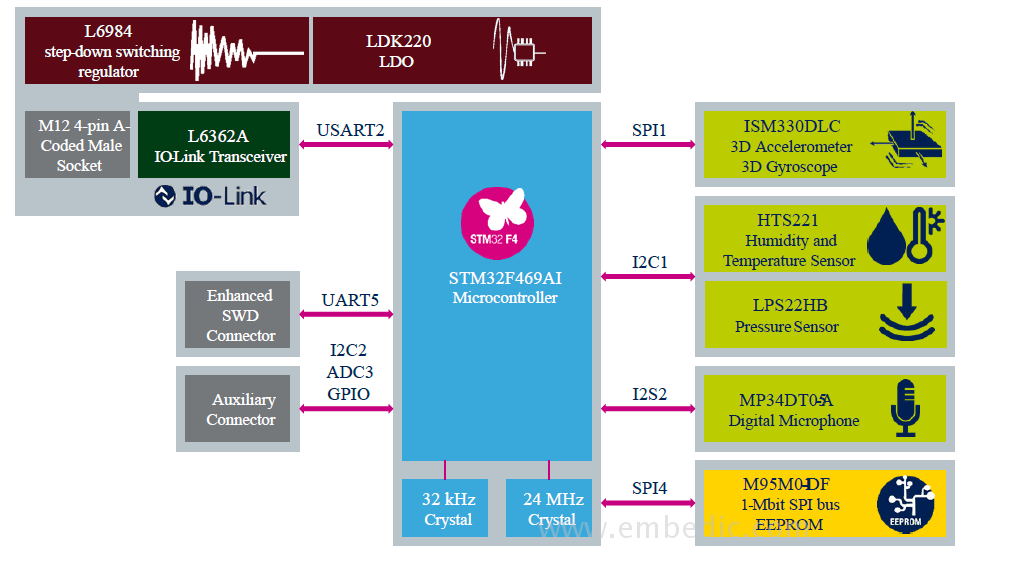
► In addition to regular maintenance, monitoring at any time is also very important
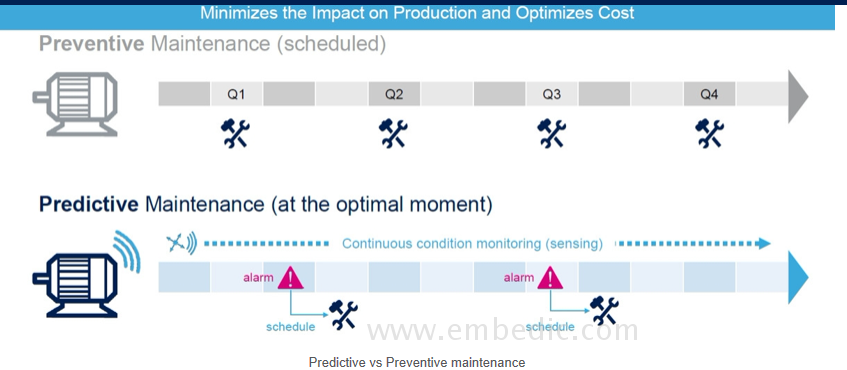
► Multiple detection IO-LINK complete industrial control suite with user graphical interface
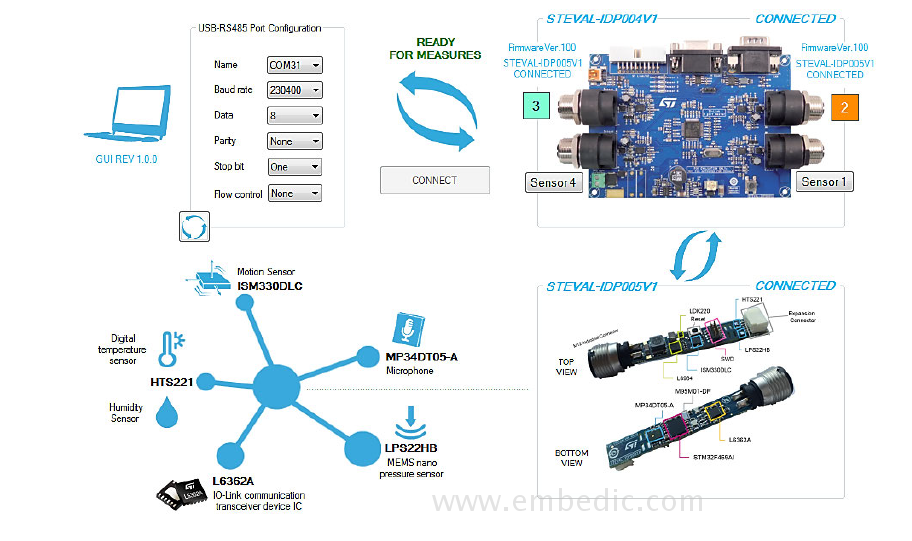
► The whole system consists of the following functional subsystems:
The connection options are:
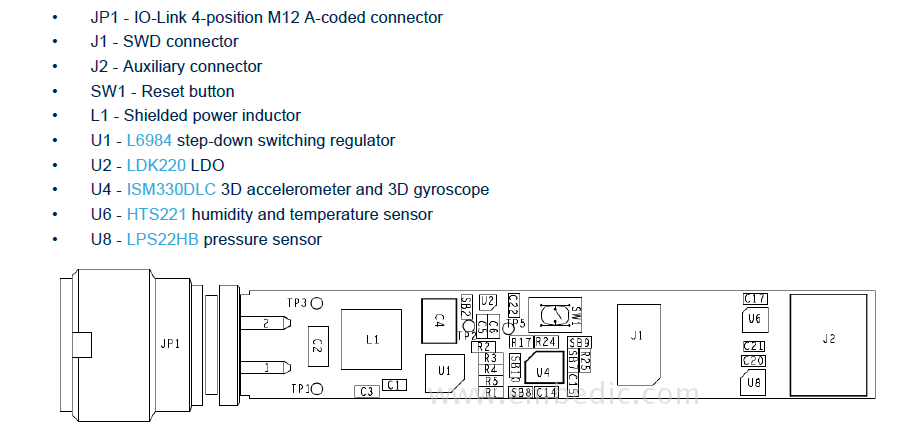
► Reverse
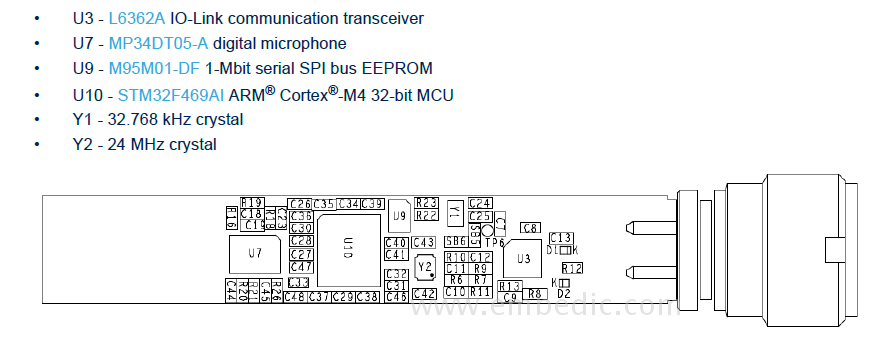
► Environmental monitoring screen
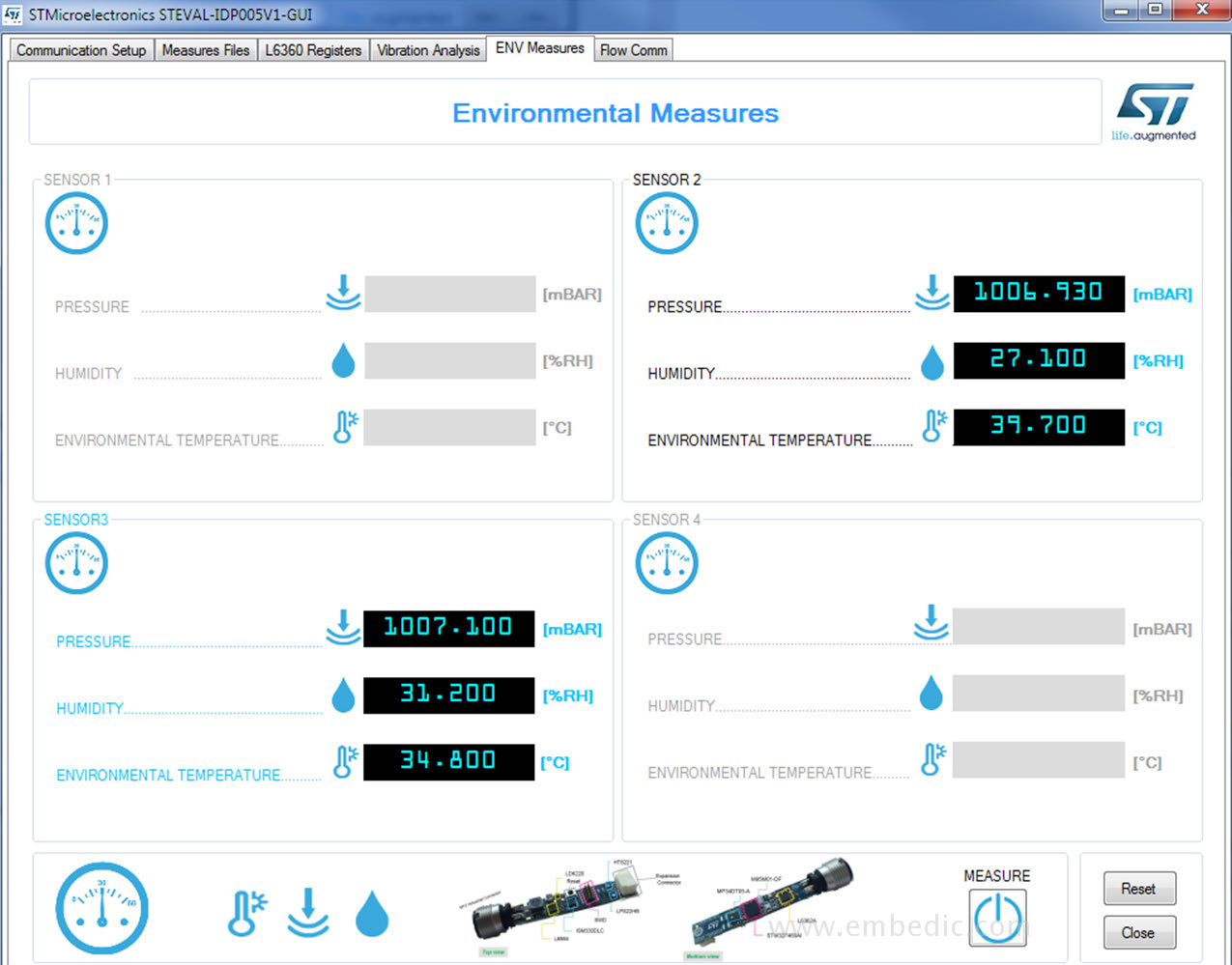
► Core technical advantages
Rotating equipment such as motors, pumps and fans can be monitored in the time and frequency domains, up to the bandwidth function of the accelerometer output data rate (up to ODR/2 = 3.3kHz).
-For the frequency domain: Programmable Fourier Transform (FFT)
◦Programmable FFT size (256,512,1024,2048)
◦Programmable FFT input data overlap
◦Programmable FFT input data window (Flat Top, Hanning, Hamming)
◦Programmable FFT output average
◦Programmable FFT sub-range analysis
-For time domain:
◦HP filtering to reduce accelerometer offset
◦ Accelerometer maximum peak evaluation
◦ Accelerometer integrated to evaluate speed
◦Mobile RMS speed evaluation
• Middleware with microphone algorithm:
-PDM to PCM
- a
-Audio FFT
Sample application with programmable warning and alarm thresholds in the time domain and across the spectrum.
It can be easily transplanted among different STM32 MCU series. Monitor PC data through any free terminal emulator
Demonstration software for communication with dedicated PC GUI
The layout meets the requirements of IEC61000-4-2 / 4 and EN60947 for industrial applications
► Solution specifications
A compact solution for condition monitoring and predictive maintenance based on 3D digital accelerometers, environmental and acoustic MEMS sensors
Main power supply voltage: 18 V-32 V.
Main ingredients:
32-bit ARM®Cortex®-M4 core (STM32F469AI) for signal processing and analysis
iNEMO 6DoF (ISM330DLC)
Absolute digital pressure sensor (LPS22HB)
Relative humidity and temperature sensor (HTS221)
Digital microphone sensor (MP34DT05-A)
IO-Link PHY device (L6362A)
EEPROM (M95M01-DF) is used for data storage
Step-down switching regulator and LDO regulator (L6984 and LDK220)
IO-Link PHY uses L6362A device transceiver to communicate with the host unit
M12 industrial connector
SWD connector for debugging and programming functions
Meet WEEE standard
RoHS compliant
IC MCU 16BIT 88KB FLASH 28SSOP
IC MCU 16BIT 32KB FLASH 44TQFP
IC MCU 8BIT 80KB FLASH 80LQFP
IC MCU 8BIT 7KB OTP 28SSOP
1
2
3
4
5
6